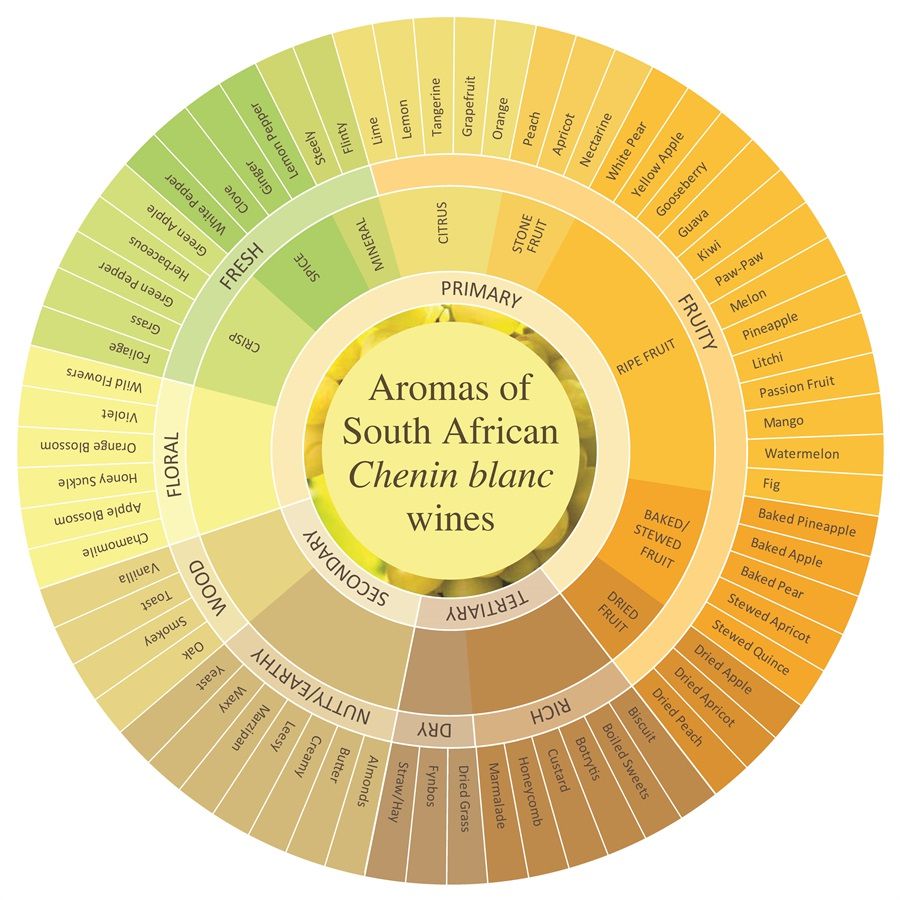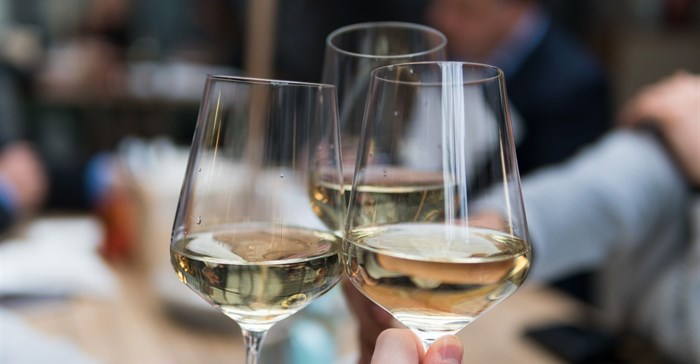Introduced in the 17th century by Dutch settlers who established trading posts at the Cape of Good Hope, Chenin blanc has a long history in South Africa. In recent years, there has been renewed research interest in the sensory characteristics of Chenin blanc within the broader context of other white wine varieties due to the economic importance of Chenin blanc for the local wine industry and export market.
Collectively, the wine varietals Chenin blanc, Sauvignon blanc and Chardonnay hold the largest share (per volumes produced) in the local white wine category. The grape is cultivated in diverse regions across South Africa’s wine producing areas due to its high yields and adaptability to hot and dry climatic conditions, occupying more than 18% of all local vineyards. The wines have also gained prominence in recent decades as a result of a shift from bulk production towards premium quality table wines that have been scooping up many international awards. As a result, local consumption and the export of Chenin blanc wines has also been on the rise since 2002.
Mining wine data
South African Chenin blanc wines take centre stage in a first-of-a-kind study that explores the sensory space of wine using data mining and machine learning techniques. Researchers employed techniques that are usually utilised to analyse “big data” and pinpoint computer hackers, among others.
They used sensory descriptors of 7,000 local wines to visualise the sensory space of Chenin wines. The results of this study, titled Modelling the sensory space of varietal wines: Mining of large, unstructured text data and visualisation of style patterns, has recently been published in Nature Scientific Reports.
This collaboration between information science and wine science on this project opens up new investigations towards understanding the field of sensory science...
Scientists from Stellenbosch University’s (SU) Institute of Wine Biotechnology, the Faculty of AgriSciences and the Department of Information Science contributed to this study.
The connection between Chenin blanc and SU dates back to 1963, when Prof Chris Orffer, then head of the Department of Viticulture, settled the uncertainty about the identity of the grape variety known as ‘Steen’ when his research showed Steen and Chenin blanc to be the same.
The research team used unstructured text data sets containing sensory wine descriptions to visualise the sensory space. The team consisting of Carlo Valente (MAgric student at IWBT) and his study-leaders Prof Florian Bauer and Dr Hélène Nieuwoudt, joined forces with Fritz Venter (PhD student, Department of Information Science) and his supervisor, Prof Bruce Watson to produce this work.
Their research explores one of the most comprehensive and data-rich sources of publicly available information on South African wines, namely the annually published John Platter Wine Guide to South African Wines. The Platter’s Wine Guide contains entries from some 1,300 South African wine cellars and 15,000 individual wines. Several hundred new wines are entered into the guide each year. A panel of Platter’s appointed wine experts with extensive knowledge assesses the wines for their sensory attributes and quality.
Identifying styles within varietal wines using data visualisation
The researchers used a data visualisation technique known as formal concept lattices in combination with traditional statistical methods to visualise the sensory attributes of Chenin blanc and Sauvignon blanc wines. This technique is normally used in information science and machine learning (a method of data analysis that automates analytical model building).
This is the first study to apply these methods to identify styles within varietal wines, says Dr Nieuwoudt, a senior researcher in SU’s Department of Viticulture and Oenology. Nieuwoudt explains, “Although this method has been used in computational linguistics and cybersecurity, this is the first attempt to model the sensory space of a wine varietal in this way.” This collaboration between information science and wine science on this project opens up new investigations towards understanding the field of sensory science, she believes.
Complexity is an important driver of South African Chenin blanc wine styles, known for having a diversity of styles.
The researchers also considered the unstructured sensory data on 4,352 Sauvignon blanc wines published in Platter’s Wine Guide for the same period (2008-2014) to confirm their findings. The sensory characteristics of Sauvignon blanc are well documented and based on established sensory and statistical methods.
The total number of words used by Platter wine panellists to describe the 2,746 Chenin blanc wines in this study amounted to 38,403, and 71,892 words for 4,352 Sauvignon blanc wines. Since the researchers were only interested in aroma attributes, they removed all non-sensory words from the original data set and eliminated duplicates. A total of 266 and 250 different aroma sensory words were identified for Chenin blanc and Sauvignon blanc wines respectively.
“Complexity is an important driver of South African Chenin blanc wine styles, known for having a diversity of styles,” says Nieuwoudt. “Although some Chenin blanc wines share similar sensory descriptors with Sauvignon blanc wines, our study showed two distinct styles of wines when the data is visualised. This represents the sensory space of both."
Nieuwoudt elaborates, “Aroma sensory attributes that are unique to or strongly associated with either group, were also identified. We found a large overlap of sensory descriptors between the varietals.”
These findings have important implications for South Africa’s Chenin blanc wine style labelling. “The main sensory dimension of our Chenin blanc wines is related to complexity, and includes a spectrum ranging from fresh and crisp wine styles towards complex wines with noticeable wood character,” Nieuwoudt explains. “This study also shows how interactive data visualisation and mining methods can be applied to extract useful insights in other areas such as sensory science.”
The sensory cues are used to develop a colour-coded aroma wheel and unique lexicon for describing South Africa’s diverse styles of Chenin blanc wines.

Chenin blanc Aroma wheel (Image Supplied)
South African Chenin blanc has really come into its own, setting a benchmark in terms of quality and versatility of style. “Chenin blanc offers something unique to consumers, and we are now able to illustrate its diverse sensory attributes visually,” says Nieuwoudt.
The full article can be viewed on Nature Scientific Reports.


























